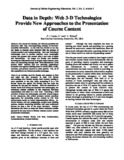Data in Depth: Web 3-D Technologies Provide New Approaches to the Presentation of Course Content
Author
Lesko, Charles J. Jr.; Pickard, John L.
Abstract
For nearly two decades, the Web has provided the
classroom with vast, ever-expanding volumes of browseraccessible
information. As the web has evolved so too has
our desire to become more involved with the process of
content-creation and content-sharing. Now new web-based
technologies look to provide smarter, more meaningful
content and present that content with a new level of depth
and interactivity. No longer are faculty and students
browsing for information that is largely static; instead, these
users are interacting through their three-dimensional (3-D)
proxies (their avatars) and are querying applications
(semantic web agents) soliciting them to collect, filter, verify,
correlate, and present answers to their queries. Yet, all of
this capability is not without potential challenges.
There is an evolving need for faculty and students to find
and build out new structure in their 3-D virtual
surroundings that visually enables their content, making it
more palatable to the user while presenting it in a 3-D
format verses the typical 2-D format that has been the
mainstay for the past two decades. With the maturation of
virtual world (3-D Web) and semantic web technologies, the
web-based content available in the classroom increases
exponentially and takes on a new look. Following a brief
overview of these two technologies and their overall impact
in the classroom, this article presents several practical
approaches for presenting course content in 3-D Web
environments based on recent implementation efforts. In-
World lectures and lab assignments, project team briefing
sessions, student mentoring activities, and open conference
forums are just a few of the areas discussed. Further
discussions also focus on setup and future evaluation studies
planned in the near-term to further evaluate course content
presentation techniques.
Subject
Date
2010
Citation:
APA:
Lesko, Charles J. Jr., & Pickard, John L.. (January 2010).
Data in Depth: Web 3-D Technologies Provide New Approaches to the Presentation of Course Content.
Journal of Online Engineering Education,
1(2),
1-
6. Retrieved from
http://hdl.handle.net/10342/3788
MLA:
Lesko, Charles J. Jr., and Pickard, John L..
"Data in Depth: Web 3-D Technologies Provide New Approaches to the Presentation of Course Content". Journal of Online Engineering Education.
1:2. (1-6),
January 2010.
April 24, 2024.
http://hdl.handle.net/10342/3788.
Chicago:
Lesko, Charles J. Jr. and Pickard, John L.,
"Data in Depth: Web 3-D Technologies Provide New Approaches to the Presentation of Course Content," Journal of Online Engineering Education 1, no.
2 (January 2010),
http://hdl.handle.net/10342/3788 (accessed
April 24, 2024).
AMA:
Lesko, Charles J. Jr., Pickard, John L..
Data in Depth: Web 3-D Technologies Provide New Approaches to the Presentation of Course Content. Journal of Online Engineering Education.
January 2010;
1(2):
1-6.
http://hdl.handle.net/10342/3788. Accessed
April 24, 2024.
Collections

